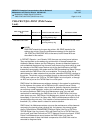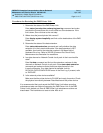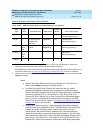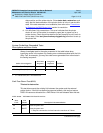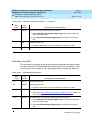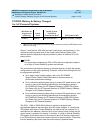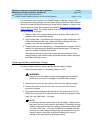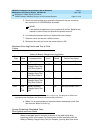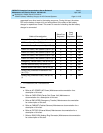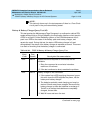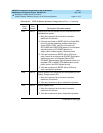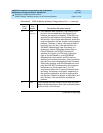
DEFINITY Enterprise Communications Server Release 5
Maintenance and Test for R5vs/si
555-230-123
Issue 1
April 1997
Maintenance Object Repair Procedures
Page 10-1123POWER (Battery & Battery Charger) for AC-Powered Systems
10
In a multicarrier cabinet system, the POWER (Battery & Battery Charger) MO
represents the battery charger and the battery which are located in the lower left
corner of the cabinet. Should anything go wrong with the battery or charger, they
must be replaced using the procedure described in ‘‘
Replacing the Battery and
Battery Charger’’ below. The system detects one of the following three problems
with the batteries or charger:
1. Reserve Fault—The charger has detected a problem within itself or the
batteries and has notified the system.
2. High Charge Rate—The batteries are charging at a high charge rate. This
means that batteries with a low charge are being recharged or that a
problem may exist with the batteries or the charger.
3. Prepare to Disconnect (Low Battery)—The batteries are in danger of being
drained to a point where the batteries would be damaged. This warning
often occurs after multiple power failures.
The batteries take 30 hours to fully charge after being drained. A fully
charged battery pack should bridge two power failures without causing a
low battery warning to occur.
Replacing the Battery and Battery Charger
Use the procedure below to replace the Battery and Battery Charger:
1. Move the power switch on the battery charger to OFF.
!
WARNING:
Always turn off the battery charger before replacing the batteries.
Failure to do so results in damage to the 397B battery charger.
2. Disconnect the cord from the outlet on the front of the battery charger.
3. Remove the screw at the top left of the cover and open the cover to
access the charger.
4. Check the battery voltages at the test points. The test points on the CE
Distribution Unit check all 3 batteries wired in series (the voltages should
read 144 volts, 3X48 volts = 144 volts) .
NOTE:
An ordinary voltmeter can be used to check battery voltages at the
test points, but it may not produce valid results. If the battery voltage
readings are below 48 volts (the voltages at test points should read
144 volts, 3X48 volts = 144 volts), the battery is probably defective.
However, a normal voltage reading does not necessarily mean the
battery is good; under load, a defective battery with a normal
reading on the voltmeter may discharge rapidly.




